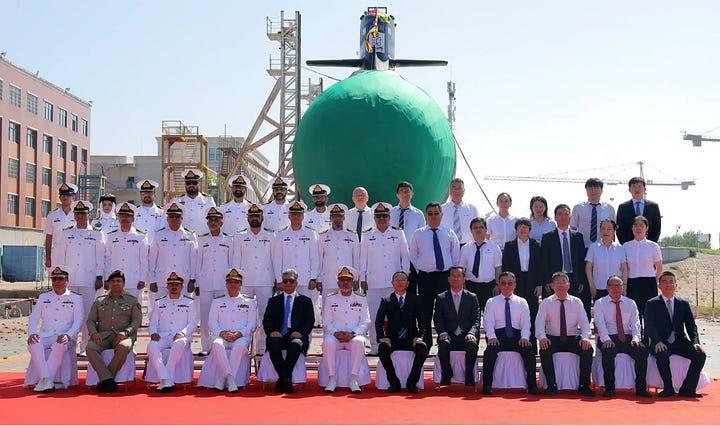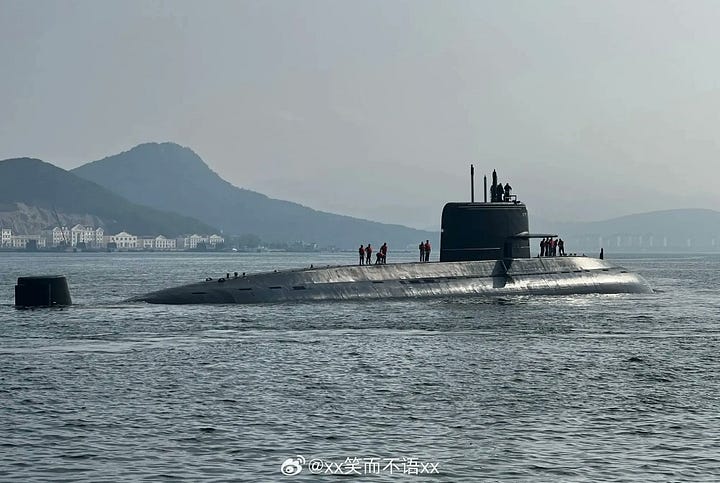Ongoing Delays In Submarine Construction, May 2025 India-Pakistan Conflict Highlight Pakistan's Undersea Shortcomings
🇮🇳 🇵🇰
Note: The following text was originally posted on my X/Twitter account.
Satellite imagery recently highlighted by Indian media indicates that much of the Pakistan Navy relocated westward to the port of Gwadar, which is located close to the Iran-Pakistan border, from the Karachi area, which is home to the Pakistan Navy's main operating base during the May 2025 India-Pakistan War.
While much remains uncertain about the brief May 2025 India-Pakistan War, the conflict raises questions about the prudence of Pakistani naval planning and force modernization efforts in a context in which the Pakistani surface fleet was too weak vis-a-vis India to have left port to undertake patrols in the Arabian Sea during a brief but high-intensity and high-stakes crisis-turned-conflict. Given how the naval dynamic of the May 2025 India-Pakistan War appears to have played out, Pakistan faces strong incentives to refocus its efforts and limited resources toward its submarine force and its ground- and air-launched maritime strike capabilities more generally.


The third of Pakistan's eight planned Chinese-designed Hangor-class diesel-electric submarines, which is the Pakistan-specific export version of the Type 039B-class submarine used by the People's Liberation Army Navy—was recently launched in Wuhan, China. Four submarines—including the three that have been launched to date—will be built in China, while the remaining four will be built in Karachi. Pakistan has previously built French-designed Agosta-90B-class diesel-electric submarines under licence in Karachi and is not, therefore, without experience in submarine construction. Even so, the Hangor-class program has experienced significant delays, and all eight boats may not be operational by 2030 as originally envisaged. A decade after Pakistan ordered the Hangor-class, not one of these submarines, including the four boats that will be built in China, is operational.
Pakistan's Hangor-class diesel-electric submarines are widely expected to have a significant, if not a primary, nuclear weapons delivery role. In the absence of discernible modifications to the Hangor-class, namely the presence of one or more vertical launch cells that can accommodate a submarine-launched ballistic missile, the Hangor-class submarines tasked with nuclear patrols, which may or may not amount to a subset of the serviceable submarines that are at sea/ready to leave port on short notice, will likely be limited to nuclear-armed land-attack cruise missiles. Pakistan is likely to use a nuclear-armed version or derivative of the Babur-3 land-attack cruise missile.
Diesel-electric submarines—even those equipped with an air-independent propulsion (AIP) system in the manner of the Hangor-class and the underlying Chinese Type 039B-class, which are equipped with a Stirling closed-cycle heat engine—have very limited submerged range-endurance. These submarines are, as such, poorly suited to a continuous at-sea nuclear deterrence role, which is likely what Pakistan requires given the very limited strategic depth and early warning afforded by the country's geography in the current technological environment. It goes without saying that any Pakistani submarines—and surface ships more generally—that remain in port—whether Karachi or Gwadar, which is about as far west as one can go along Pakistan's coastline—will be highly vulnerable to Indian air and missile strikes, a dynamic that was vividly on display across Pakistan in May 2025. The patrol duration of nuclear-armed Hangor-class submarines is likely to be limited—20 or so days when wholly reliant on the AIP, unless the Hangor-class is fitted with higher energy density/specific energy lithium ion batteries—and 3-4 of the planned 8 Hangor-class submarines are likely to be tied up with sustaining a single nuclear-armed submarine at sea on a constant basis.
Given the above and with the naval aspect of the May 2025 India-Pakistan War in mind, there is a case to be made that Pakistan will likely have to deploy a significantly larger—larger than the 8 planned Hangor-class boats—submarine force. This is difficult for any country to do, not least a country in Pakistan's perennially precarious economic and fiscal state. While Chinese largesse—which is ultimately self-interested given the scope for the growth in Pakistani military capabilities vis-a-vis India to offset and even throttle the growth of Indian military capabilities vis-a-vis China—in this area is a possibility, the more prudent approach will be for Pakistan to fundamentally rethink how it goes about modernizing its surface fleet and the roles that its qualitatively and quantitatively inferior surface fleet can realistically play in times of peace, crisis, and war vis-a-vis India.

